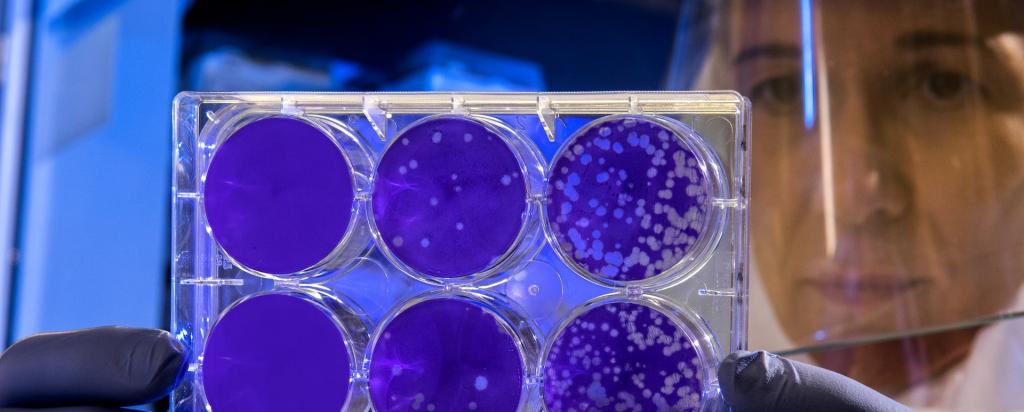
Published on the 3rd September 2015 by ANSTO Staff
ANSTO has collaborated on research with the University of Newcastle upon Tyne and ISIS that has produced the first in vitro model of the outer membrane of the bacteria Escherichia coli (E.coli), which is expected to be used as a robust tool for developing antibiotics and other drugs. Single-cell gram negative bacteria, such as E.coli, are increasingly a source of antibiotic-resistant infections.
Instrument Scientist Stephen Holt is a co-author of the research, which has just been published as a ‘Hot Paper’ by the prestigious journal Angewandte Chemie. Lead author is Prof Jeremy Lakey of the University of Newcastle, with whom Holt has collaborated for a decade on the study of bacterial outer membranes. Dr Luke Clifton from the ISIS neutron spallation source was also a lead author.

A stable in vitro model of E.coli is important because the structure and dynamics of the membrane in vivo is poorly understood. The outer membrane, or envelope, is only 20 nanometres thick.
“We’ve demonstrated in different ways using neutron scattering that the model behaves in a way that you would expect if you were to do things to a living bacteria,” said Holt.
Gram negative bacteria, such as E.coli, have a protective outer surface that unusually is composed of two layers — the so-called inner cell membrane and an outer membrane. This double membrane which is unique in biology is highly impermeable to incoming molecules; it acts as a highly selective filter.
E.coli is a highly successful organism. In evolutionary terms, it is believed to have descended from a common ancestor of cyanobacteria, which emerged 3.6 billion years ago. E.coli bacteria live in the digestive tract of people and animals and most are harmless. However, some forms of E.coli cause illness.
The inner and outer membranes are very different. The outer membrane is a complex, asymmetrical structure composed of lipopolysaccharides (LPS) that are attached to a lipid bilayer by varying lengths and types of phosphorylated sugar chains. The lipid bilayer is made up of two types of phospholipids. Calcium and magnesium ions link the core polysaccharides of adjacent LPSs in the upper strand of the bilayer.
It is the physical properties of the membrane barrier that limits the effectiveness of antimicrobials and mutations to outer membrane proteins are thought to contribute to the development of antibiotic resistant strains.
The researchers started construction of the synthetic model with a flat gold layer that chemically adheres to silicon substrate through a nickel-iron magnetic alloy. Gold is coated with a monolayer of the phospholipid (the inner membrane), which is covered in a layer of water. The water layer in the model is thinner than the periplasm in the bacteria.
The deposition of the free floating outer bilayer was more challenging as the system is not self-assembling. To create it, they needed to use laboratory methods (Langmuir-Blodgett/Langmuir Schaeffer) to compress and stack monolayers of molecules horizontally and vertically.
In this case, they needed a phospholipid layer with hydrophilic (like water) heads pointing down joined to a phospholipid layer with hydrophobic (doesn’t like water) tails pointing up.
“Although we have used a truncated version of LPS, the structure replicates the crucial elements of a bacterial membrane using much more complex lipids than have typically been used,” said Holt.
The lipopolysaccharide core is attached to the phospholipid layer by phosphorylated sugar chains cross linked by magnesium and sodium ions with a positive charge.
They tested the stability of the model by removing the calcium and magnesium ions with a solution of EDTA (edetic acid). “If you take the calcium or magnesium out, the whole thing is destabilised because the charges in the outer leaflet repel each other.”
The structure of the model was confirmed using neutron reflectometry. They had to deuterate the lipids (replacing hydrogen with deuterium) to make them more readily detectable by neutrons.
“In a simplistic view, we treat each of the different components as a layer and the technique allows us to look at the position of the layers relative to the substrate.”
The reflectometry, which was undertaken at ISIS (Oxford, UK), confirmed that the floating, supported bilayer (FSB) mimicked the unusual asymmetric structure of the membrane.
Adding the antimicrobial proteins, lysozyme and lactoferrin caused the disruption of the outer membrane bilayer. This was confirmed with neutron reflectometry.
“We’ve explained how these agents interact with the model system on a molecular basis,” said Holt. “And the explanation agrees really well with the way those two proteins behaved when introduced to a solution of E.coli.”
The next challenge for the researchers is to begin incorporating membrane proteins into the bilayer.